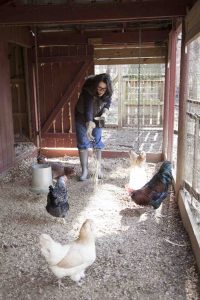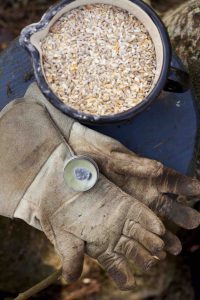Celebrities In The Henhouse
By Ashley English
Most of us have a guilty pleasure, that thing we do with some degree of shame but a greater amount of joy. My own is deeply voyeuristic and profoundly trite: reading celebrity gossip.
When facing an intense deadline on a writing project, my first instinct is to open a browser tab and type in a famous person’s name. My favorite is the “celebrities: they’re just like us” genre: Demi Moore getting a latte, Beyoncé at the farmers market, Martha Stewart sunning poolside.
These glimpses into the “normal” lives of famous folks always give me a chuckle—because their lives of course in no way resemble ours. All of which reminds me of my backyard chickens. I realize you may be rolling your eyes right now, but stick with me. In the winter months, I spend a lot of time thinking about my flock, six laying hens and one rooster. Their needs change when the mercury plummets, and they rely on my stewardship more than at any other time of the year. In thinking about how best to care for them, I came to a realization. Unlike celebrities, chickens really are just like us.
Before you balk—squawk?—at such a statement, let me present my case. When temperatures are frosty, chickens can suffer damage, or even frostbite, to their extremities. Just as I lather my face in shea butter and my lips with balm, I apply a thick salve to the chickens’ combs and wattles whenever temperatures remain near or below freezing for more than two days. I do this at sundown, when they’re all nicely lined up on their perches and don’t seem to care what I’m up to.
Chickens, like us, also require extra bedding in winter. Each November, I change out the thin cotton sheets and lightweight coverlets on my family’s beds in favor of flannel and fleece. In the henhouse, I bulk up the cedar bedding material in the nesting boxes and add another layer to the henhouse floor. In an unheated space, a bit of extra insulation goes a long way.
Dietary needs change as well. Just as the robust soups and stews we cook from December to March fortify our constitutions—and sometimes our waistlines—the flock receives extra calories in the form of scratch corn, or coarsely cracked grains, to supplement their year-round diet of poultry feed. The fattiness of the scratch allows the birds to pack on extra body fat and keep warm.
Finally, chickens, like people, get a bit stir crazy when snowed in. I dig a pathway for my flock so they can exercise outdoors without having to climb snowdrifts, which can damage their feet. All this requires extra effort on my part, but the chickens deserve it, and my family benefits as well.
If you care for your flock as you care for yourself in the winter, the hens will reward you with fresh, nutritious eggs, even though their total output is reduced. The sunniness of their yolks, coupled with another wintry gift—ripe citrus—can be transformed into delicious curd, one of the best antidotes to winter’s doldrums.
Celebrities and chickens—they’re just like us!
Save
Save
Save
Save
Save
Save
Save
Save
Save
Save

Ashley English provides additional care for her chickens in winter. Photos by Erin Adams.

The author provides more calories for her chickens in winter, in the form of scratch corn or coarsely cracked grains. Photos by Erin Adams.
THE WEEKLY REVEL
Sign up for your free handpicked guide to enjoying life around Asheville.
Available weekly from May to October.





